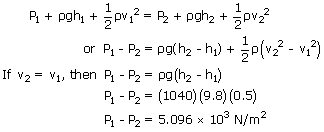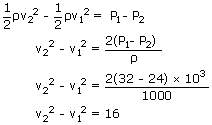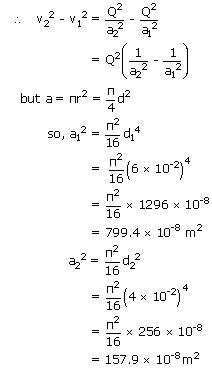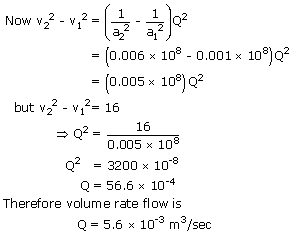Water enters a horizontal pipe of non-uniform cross-section with a velocity of 0.6m/s and leaves the other end with a velocity of 0.4m/s. At the first end, pressure of water is 1600N/m2. Calculate the pressure of water at the other end. Density of water = 1000 kg/m3?

| where, ρ is the density of water | = | 1000kg/m3 |
| v1 is the velocity at first point | = | 0.6m/s |
| P1 is the pressure at first point | = | 1600N/m2 |
| v2 is the velocity at second point | = | 0.4m/s |
| P2 is the pressure at second point | = | ? |

Calculate the minimum pressure required to force the blood from the heart to the top of the head (vertical distance 0.5m). Assume the density of blood to be 1040kg/m3. Friction is to be neglected ?

An airplane wing is designed so that the speed of the air across the top of the wing is 251m/s when the speed of the air below the wing is 225m/s. The density of air is 1.29kg/m3. What is the lifting force on a wing of area 24m 2?

| we know that pressure | = |  |
| Net upward force | = | (pressure difference) Area of the wing |
| Given area of the wing | = | 24m2 |
| So, force | = | 7982.52 × 24 |
| = | 1.92 × 105 N |
Water is circulating through a closed system of pipes in a two floor apartment. On the first floor, the water has a gauge pressure of 3.4 × 10 5 pa and a speed of 2.1m/s. However, on the second floor, which is 4m higher, the speed of the water is 3.7m/s. The speeds are different because the pipe diameters are different. What is the gauge pressure of the water on the second floor?

Water stands at a depth H in a large, open tank whose side walls are vertical. A hole is made in one of the walls at a depth h below the water surface. What is the distance R from the foot of the wall does the emerging stream strike the floor?





A 6cm diameter horizontal pipe gradually narrows to 4cm when water flows through this pipe at a certain rate, the gauge pressure in these two sections is 32 kpa and 24 kpa respectively. What is the volume rate of flow?




